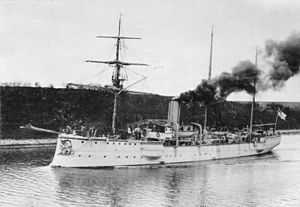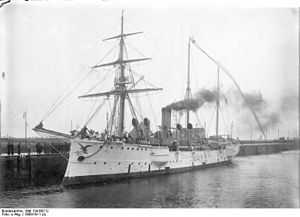Schwalbe-class cruiser
 Schwalbe in the Kaiser Wilhelm Canal | |
| Class overview | |
|---|---|
| Preceded by: | None |
| Succeeded by: | Bussard class |
| Built: | 1886–1889 |
| Completed: | 2 |
| Scrapped: | 2 |
| General characteristics | |
| Type: | Unprotected cruiser |
| Displacement: | 1,359 t (1,338 long tons; 1,498 short tons) |
| Length: | 66.9 m (219 ft 6 in) |
| Beam: | 9.36 m (30 ft 9 in) |
| Draft: | 4.4 m (14 ft 5 in) |
| Propulsion: | 2-cylinder double expansion engines, 2 screws |
| Speed: | 13.5 knots (25.0 km/h) |
| Range: | 3,290 nmi (6,090 km) at 10 knots (19 km/h) |
| Complement: | 9 officers 108 enlisted men |
| Armament: | 8 × 10.5 cm (4.1 in) K L/35 guns 5 × 37 mm (1.5 in) revolver cannons |
The Schwalbe class of unprotected cruisers were the first ships of the type built for the German Kaiserliche Marine (Imperial Navy). The class comprised two ships, Schwalbe, the lead ship, and Sperber. They were designed for service in Germany's recently acquired colonial empire, and were built between 1886 and 1889. They were armed with a main battery of eight 10.5-centimeter (4.1 in) guns and could steam at a speed of 13.5 knots (25.0 km/h; 15.5 mph).
Schwalbe and Sperber spent their active careers abroad, usually in Germany's African colonies or in the Pacific. The two cruisers assisted in the suppression of the Abushiri Revolt in German East Africa in 1889–1890. By the end of the 1890s, both ships had been overhauled and decommissioned in Germany. They returned to service at the turn of the century for another tour overseas; Schwalbe joined the forces that battled the Boxer Rebellion in China in 1900 before being decommissioned a second time in 1902. Sperber remained in Africa until 1911, when she too was decommissioned. Schwalbe was used as a training ship after 1912 and Sperber was used as a target ship during World War I. Both vessels were sold in 1920 and broken up in 1922.
Design
The ships of the Schwalbe class were designed for use in Germany's recently acquired overseas colonies. These newly conquered territories required warships to police them, and at the time, the German Kaiserliche Marine (Imperial Navy) possessed a motley collection of older sailing ships that were suitable only for training purposes.[1] The design was prepared in 1886–1887,[2] under the tenure of General Leo von Caprivi, the Chief of the Kaiserliche Marine; Caprivi sought new cruisers that would have strong fighting capabilities in addition to traditional overseas cruiser characteristics.[1] The Schwalbe class was the first unprotected cruiser design built in Germany, and along with several other small warships, they permitted Caprivi to retire five old sailing frigates and modernized the German cruiser force.[3]
General characteristics
The ships of the Schwalbe class were 62.59 meters (205.3 ft) long at the waterline and 66.9 m (219 ft) long overall. They had a beam of 9.36 m (30.7 ft), though over the sponsons for the main guns, the beam increased to 10.1 m (33 ft). The ships had a draft of 4.4 m (14 ft) forward and 4.72 m (15.5 ft) aft. They displaced 1,111 metric tons (1,093 long tons; 1,225 short tons) as designed and up to 1,359 t (1,338 long tons; 1,498 short tons) at full combat load. The ships' hulls were constructed with a transverse framing composed of steel, wood, and copper. Their stem and stern were made of wood, and a bronze ram was mounted at the bow. The hull was divided into eleven watertight compartments.[4]
The two cruisers were good sea boats, and were very maneuverable. They suffered from severe weather helm, and tended to roll badly in a beam sea; their metacentric height was .665 m (2 ft 2.2 in). They lost little speed in a head sea. Schwalbe and Sperber each had a crew of 9 officers and 108 enlisted men. They carried a number of small boats, including one picket boat, one cutter, one yawl, and one dinghy.[5]
Propulsion
Their propulsion system consisted of two horizontal 2-cylinder double-expansion steam engines powered by four coal-fired cylindrical water-tube boilers trunked into a single funnel. The engines drove a pair of 3-bladed screw propellers that were 2.8 m (9 ft 2 in) wide in diameter. The ships' engines provided a design speed of 13.5 kn (25.0 km/h; 15.5 mph) and a range of approximately 3,290 nautical miles (6,090 km; 3,790 mi) at 10 kn (19 km/h; 12 mph). On trials, both ships exceeded their rated speeds, with Schwalbe reaching 14.1 knots (26.1 km/h; 16.2 mph) and Sperber making 14.3 knots (26.5 km/h; 16.5 mph). At these speeds, the cruising radius fell to 1,630 nmi (3,020 km; 1,880 mi).[4] To supplement the steam engines, the ships were fitted with a barquentine rig.[6] Steering was controlled by a single rudder. Schwalbe was fitted with one electricity generator rated at 5 kilowatts (6.7 hp) at 67 volts during her modernization in 1903.[2]
Armament
Since Caprivi sought overseas cruisers that would still have significant combat power, the ships were armed with a relatively heavy battery—for ships of their size—of eight 10.5 cm K L/35 guns. These guns were placed in single pedestal mounts and were supplied with 765 rounds of ammunition in total. They had a range of 8,200 m (26,900 ft). Four of the guns were mounted in sponsons, with two side by side forward and aft. The remaining four guns were placed amidships in gun ports.[4] Four guns were mounted on each broadside. The gun armament was rounded out by five 37 mm (1.5 in) revolver cannon.[6]
Ships
| Name | Builder | Laid down | Launched | Commissioned |
|---|---|---|---|---|
| Schwalbe | Kaiserliche Werft, Wilhelmshaven | 1886 | 16 August 1887 | 8 May 1888 |
| Sperber | Kaiserliche Werft, Danzig | 1887 | 23 August 1888 | 2 April 1889 |
Service history

Schwalbe and Sperber spent the majority of their careers on Germany's colonial stations, where they policed the colonies, suppressed unrest, and showed the flag. Both ships were initially called to German East Africa to help put down the Abushiri Revolt in 1889–1890.[7] Schwalbe remained in the colony after the rebellion was suppressed, but Sperber left for the South Seas Station in German New Guinea.[8] In mid-1893, Schwalbe was recalled to Germany for a major overhaul,[9] and Sperber was similarly ordered to return at the end of the year, but while en route she was sent to German Southwest Africa instead. Sperber finally returned to Germany in late 1897 for her overhaul, which was completed the following year.[10] Both ships were decommissioned after their overhauls were finished.[11]
In April 1898, Schwalbe was recommissioned for another tour abroad. She first returned to German East Africa, where the Second Boer War threatened regional stability; British warships began seizing German vessels suspected of carrying contraband to the Boers. This created a major diplomatic incident and Schwalbe was sent to protect German shipping in the area. The outbreak of the Boxer Rebellion in Qing China in 1900 proved to be more pressing, and so Schwalbe was sent to join the Eight Nation Alliance that had formed to crush the Boxers. During her deployment to China, she helped blockade the Yangtze and sent landing parties ashore to control unrest in Ningpo. In mid-1902, she was recalled to Germany for a second time, was overhauled, and was again decommissioned.[12]
Sperber meanwhile had been reactivated in December 1902 in response to the Venezuela Crisis of 1902–03; she was sent there in January 1903, though by the time she arrived the crisis had subsided and she was no longer necessary. She was therefore transferred first to German East Africa, where she remained only briefly before being moved again, this time to the East Asia Squadron. She served in the unit from late 1903 to early 1905, when she was reassigned to German Southwest Africa. She returned to Germany in early 1911 and was decommissioned in July.[13] In October 1911 Schwalbe was recommissioned for use as a special purposes ship. Initially, she was to be a survey ship, but the Navy instead decided to use her to replace the old aviso Grille as a training ship. Sperber was stricken from the naval register in 1912 and used as a target ship through World War I. Schwalbe continued on as a training ship during the war until 1918, when she too was employed as a gunnery training target. Both ships were sold for scrapping in August 1920 and were broken up in 1922 in Hamburg.[5][14]
Notes
- ↑ 1.0 1.1 Sondhaus, p. 166
- ↑ 2.0 2.1 Gröner, p. 93
- ↑ Sondhaus, pp. 166–167
- ↑ 4.0 4.1 4.2 Gröner, pp. 93–94
- ↑ 5.0 5.1 Gröner, p. 94
- ↑ 6.0 6.1 Gardiner, p. 252
- ↑ Hildebrand, Röhr, & Steinmetz, p. 145
- ↑ Hildebrand, Röhr, & Steinmetz, p. 178
- ↑ Hildebrand, Röhr, & Steinmetz, p. 146
- ↑ Hildebrand, Röhr, & Steinmetz, p. 179
- ↑ Hildebrand, Röhr, & Steinmetz, pp. 146, 179
- ↑ Hildebrand, Röhr, & Steinmetz, pp. 146–147
- ↑ Hildebrand, Röhr, & Steinmetz, pp. 179–180
- ↑ Hildebrand, Röhr, & Steinmetz, pp. 147, 180
References
- Gardiner, Robert, ed. (1979). Conway's All the World's Fighting Ships 1860–1905. Greenwich: Conway Maritime Press. ISBN 0-8317-0302-4.
- Gröner, Erich (1990). German Warships 1815–1945. Annapolis, MD: Naval Institute Press. ISBN 0-87021-790-9.
- Hildebrand, Hans H.; Röhr, Albert; Steinmetz, Hans-Otto (1993). Die Deutschen Kriegsschiffe (Volume 7). Ratingen, DE: Mundus Verlag. ASIN B003VHSRKE.
- Sondhaus, Lawrence (1997). Preparing for Weltpolitik: German Sea Power Before the Tirpitz Era. Annapolis, MD: Naval Institute Press. ISBN 1-55750-745-7.
| ||||||||||||||